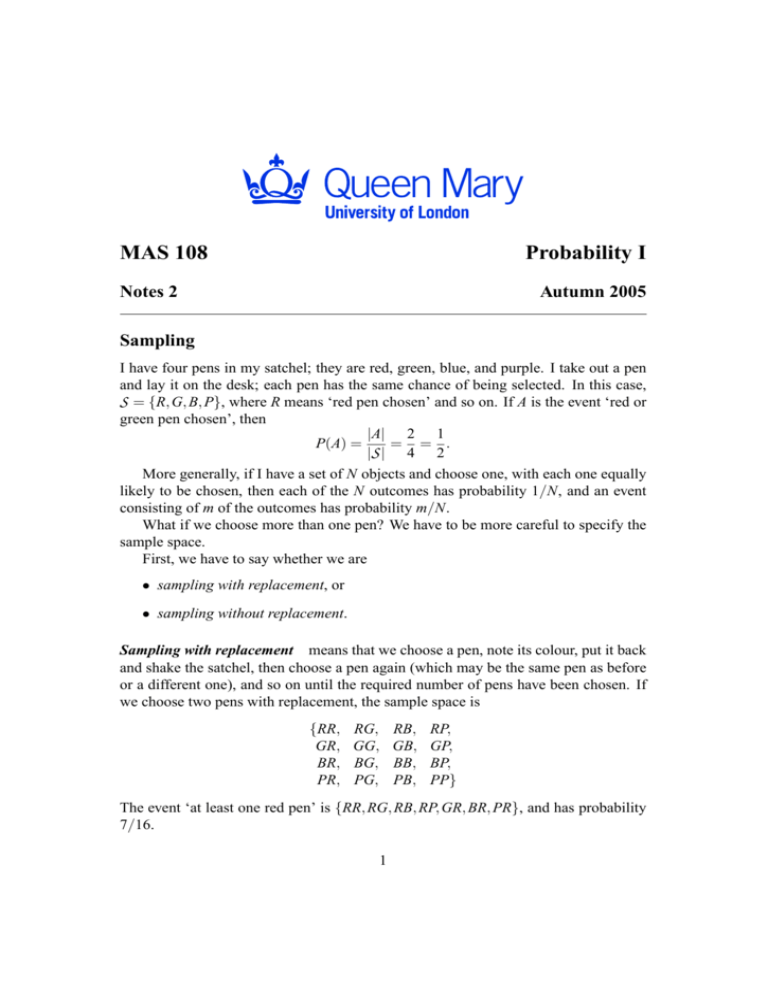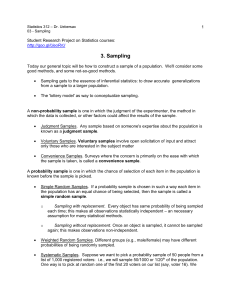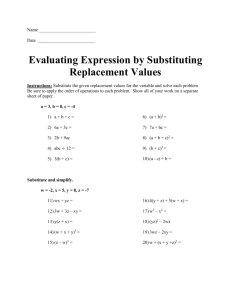Sampling without replacement
advertisement

MAS 108
Probability I
Notes 2
Autumn 2005
Sampling
I have four pens in my satchel; they are red, green, blue, and purple. I take out a pen
and lay it on the desk; each pen has the same chance of being selected. In this case,
S = {R, G, B, P}, where R means ‘red pen chosen’ and so on. If A is the event ‘red or
green pen chosen’, then
|A| 2 1
P(A) =
= = .
|S | 4 2
More generally, if I have a set of N objects and choose one, with each one equally
likely to be chosen, then each of the N outcomes has probability 1/N, and an event
consisting of m of the outcomes has probability m/N.
What if we choose more than one pen? We have to be more careful to specify the
sample space.
First, we have to say whether we are
• sampling with replacement, or
• sampling without replacement.
Sampling with replacement means that we choose a pen, note its colour, put it back
and shake the satchel, then choose a pen again (which may be the same pen as before
or a different one), and so on until the required number of pens have been chosen. If
we choose two pens with replacement, the sample space is
{RR,
GR,
BR,
PR,
RG,
GG,
BG,
PG,
RB,
GB,
BB,
PB,
RP,
GP,
BP,
PP}
The event ‘at least one red pen’ is {RR, RG, RB, RP, GR, BR, PR}, and has probability
7/16.
1
In general, if we choose n items from a set Ω of size N, and the sampling is done
with replacement, then the sample space S consists of all ordered n-tuples of the form
(ω1 , ω2 , . . . , ωn ), where ωi denotes the object taken out on the i-th occasion.
Sampling without replacement means that we choose a pen but do not put it back,
so that our final selection cannot include two pens of the same colour. In this case, the
sample space for choosing two pens is
{
RG, RB, RP,
GR,
GB, GP,
BR, BG,
BP,
PR, PG, PB
}
and the event ‘at least one red pen’ is {RG, RB, RP, GR, BR, PR}, with probability
6/12 = 1/2.
Now there is another issue, depending on whether we care about the order in which
the pens are chosen. We will only consider this in the case of sampling without replacement. Sometimes it doesn’t really matter whether we choose the pens one at a
time or simply take two pens out of the drawer; we are not always interested in which
pen was chosen first. If we are not interested then the sample space is
{{R, G}, {R, B}, {R, P}, {G, B}, {G, P}, {B, P}},
containing six elements. (Each element is written as a set since, in a set, we don’t
care which element is first, only which elements are actually present. So the sample
space is a set of sets!) The event ‘at least one red pen’ is {{R, G}, {R, B}, {R, P}},
with probability 3/6 = 1/2. We should not be surprised that this is the same as in the
previous case.
If order is important, the sample space S still consists of ordered n-tuples of the
form (ω1 , ω2 , . . . , ωn ), but now all of the ωi must be different. If order is not important
then S consists of all subsets of Ω of size n.
There are formulae for the sample space size in these three cases. These involve
the following expressions:
N! = N(N − 1)(N − 2) · · · 1
Pn = N(N − 1)(N − 2) · · · (N − n + 1)
N
Cn = N Pn /n!
N
Note that N! is the product of all the whole numbers from 1 to N; and
N
Pn =
N!
,
(N − n)!
2
so that
N
Cn =
N!
.
n!(N − n)!
Theorem The number of selections of n objects from a set of N objects is given in
the following table.
with replacement without replacement
NP
ordered sample
Nn
n
NC
unordered sample
n
In fact the number that goes in the empty box is N+n−1 Cn , but this is much harder
to prove than the others, and you are very unlikely to need it.
Here are the proofs of the other three cases. First, for sampling with replacement
and ordered sample, there are N choices for the first object, and N choices for the
second, and so on; we multiply the choices for different objects. (Think of the choices
as being described by a branching tree.) The product of n factors each equal to N is
N n.
For sampling without replacement and ordered sample, there are still N choices
for the first object, but now only N − 1 choices for the second (since we do not replace
the first), and N − 2 for the third, and so on; there are N − k + 1 choices for the kth
object, since k − 1 have previously been removed and N − (k − 1) remain. As before,
we multiply. This product is the formula for N Pn .
For sampling without replacement and unordered sample, think first of choosing
an ordered sample, which we can do in N Pn ways. But each unordered sample could be
obtained by drawing it in n! different orders. So we divide by n!, obtaining N Pn /n! =
N C choices.
n
In our example with the pens, the numbers in the three boxes are 42 = 16, 4 P2 = 12,
and 4 C2 = 6, in agreement with what we got when we wrote them all out.
Note that, if we use the phrase ‘sampling without replacement, ordered sample’,
or any other combination, we are assuming that all outcomes are equally likely.
Example The names of the seven days of the week are placed in a hat. Three names
are drawn out; these will be the days of the Probability I lectures. What is the probability that no lecture is scheduled at the weekend?
Here the sampling is without replacement, and we can take it to be either ordered
or unordered; the answers will be the same. For ordered samples, the size of the
sample space is 7 P3 = 7 · 6 · 5 = 210. If A is the event ‘no lectures at weekends’, then A
occurs precisely when all three days drawn are weekdays; so |A| = 5 P3 = 5 · 4 · 3 = 60.
Thus, P(A) = 60/210 = 2/7.
If we decided to use unordered samples instead, the answer would be 5 C3 /7 C3 ,
which is once again 2/7.
3
Example Ten coins are tossed: each is equally likely to come down heads or tails.
What is the probability that we get exactly three heads?
This is equivalent to sampling from {H, T } with replacement, so |S | = 210 = 1024.
Let A be the event ‘exactly three heads’. Then |A| is equal to the number of ways
of choosing 3 things from 7, which is
10
C3 =
10 × 9 × 8
10!
=
= 120.
3! 7!
3×2×1
If all outcomes are equally likely then P(A) = 120/1024 = 15/128 ≈ 0.117.
Example I have 10 coins in my pocket; 3 are copper and 7 are silver. I take out
4 coins, one after another. Let
D = ‘2 silver followed by 2 copper’
E = ‘all 4 are silver’
F = ‘2 silver and 2 copper, in any order’.
This is sampling without replacement.
For event D, the order matters, so we consider ordered samples. Then |S | = 10 P4 =
10 × 9 × 8 × 7. For event D we must choose an ordered sample of 2 from the 7 silver
coins followed by an ordered sample of 2 from the 3 copper coins, so |D| = 7 P2 × 3 P2 =
7 × 6 × 3 × 2. Therefore P(D) = |D|/|S | = 1/20.
For event E, we choose an ordered sample of 4 from the 7 silver coins,so |E| =
7 P = 7 × 6 × 5 × 4 and P(E) = |E|/|S | = 1/6.
4
Event F is like event D except that we have to choose which 2 of the 4 positions
should have the silver coins. There are 4 C2 ways of doing this, which is 6, so P(F) =
6P(D) = 6/20 = 3/10.
If we didn’t want to know about event D then we could use unordered samples.
Then |S | = 10 C4 and |E| = 7 C4 so
P(E) =
7!
6! 4! 1
×
= .
4! 3! 10!
6
Also, |F| = 7 C2 × 3 C2 , because each choice of two silver coins can be combined with
each choice of two copper coins. Thus
P(F) =
7!
3!
4! 6!
×
×
= 3/10.
2! 5! 2! 1! 10!
The results for E and F are the same for ordered and unordered samples, as they
should be.
4
Summary: In a sampling problem, you should first read the question carefully and
decide whether the sampling is with or without replacement. If it is without replacement, decide whether the sample is ordered (e.g. does the question say anything about
the first object drawn?). If so, then use the formula for ordered samples. If not,
then you can use either ordered or unordered samples, whichever is convenient; they
should give the same answer. (Usually it is easier to use unordered samples whenever
you can.) If the sample is with replacement, or if it involves throwing a die or coin
several times, then use the formula for sampling with replacement.
5







